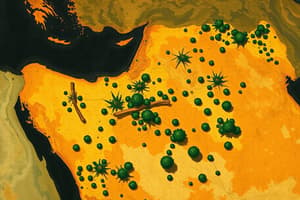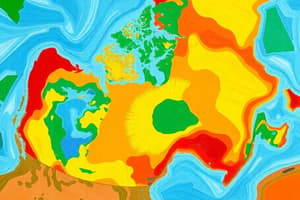Podcast
Questions and Answers
What is the formula to calculate the ground distance from a map distance?
What is the formula to calculate the ground distance from a map distance?
- Ground distance = Map distance / Scale
- Ground distance = Map distance - Scale
- Ground distance = Map distance + Scale
- Ground distance = Map distance x Scale (correct)
What is the purpose of a graticule on a map?
What is the purpose of a graticule on a map?
- To provide a network of lines for navigation
- To represent the intersection of latitude and longitude lines (correct)
- To show the location of important features
- To create a grid system for measuring distances
How many minutes are in 1 degree of latitude or longitude?
How many minutes are in 1 degree of latitude or longitude?
- 30
- 120
- 60 (correct)
- 90
What is the purpose of dividing a 1° x 1° block into four smaller blocks of 30’ x 30’?
What is the purpose of dividing a 1° x 1° block into four smaller blocks of 30’ x 30’?
What is the format of a topographic map name?
What is the format of a topographic map name?
How do you estimate the seconds in a co-ordinate?
How do you estimate the seconds in a co-ordinate?
What is the first step in locating a feature or place using co-ordinates?
What is the first step in locating a feature or place using co-ordinates?
What is the purpose of converting map distances to ground distances?
What is the purpose of converting map distances to ground distances?
What is the primary purpose of knowing how height is represented on a topographic map?
What is the primary purpose of knowing how height is represented on a topographic map?
What is the symbol used to represent Trig beacons on a 1:50 000 topographic map?
What is the symbol used to represent Trig beacons on a 1:50 000 topographic map?
What is the purpose of a benchmark on a topographic map?
What is the purpose of a benchmark on a topographic map?
How are spot heights represented on a topographic map?
How are spot heights represented on a topographic map?
What is the definition of scale in topographic mapping?
What is the definition of scale in topographic mapping?
What is the purpose of a ratio scale on a topographic map?
What is the purpose of a ratio scale on a topographic map?
What is the purpose of a line scale on a topographic map?
What is the purpose of a line scale on a topographic map?
What is the main difference between a trig beacon and a benchmark?
What is the main difference between a trig beacon and a benchmark?
What is the primary function of contour lines on a topographic map?
What is the primary function of contour lines on a topographic map?
What is the contour interval on a 1:50 000 topographic map?
What is the contour interval on a 1:50 000 topographic map?
What type of slope is indicated by contour lines that are close together at the top of the hill and gentle at the bottom?
What type of slope is indicated by contour lines that are close together at the top of the hill and gentle at the bottom?
What is the purpose of the index contour on a topographic map?
What is the purpose of the index contour on a topographic map?
What type of aerial photograph is taken by a camera angled to the vertical?
What type of aerial photograph is taken by a camera angled to the vertical?
What is the main difference between a contour line and a topographic map?
What is the main difference between a contour line and a topographic map?
What is the purpose of a vertical aerial photograph?
What is the purpose of a vertical aerial photograph?
What is the relationship between the spacing of contour lines and the slope of the landscape?
What is the relationship between the spacing of contour lines and the slope of the landscape?
Flashcards are hidden until you start studying
Study Notes
Measuring Distances on a Map
- Use a ruler to measure the distance between two places on a map
- Multiply map distance by scale to get ground distance in cm
- Divide by 100 to convert to metres
- Divide the distance in metres by 1 000 to convert to km
- Ground distance = Map distance x Scale
Co-ordinates to Locate Features
- Co-ordinates are intersections between lines of latitude and longitude
- They are given in degrees, minutes, and seconds
- There are 60 minutes in 1 degree and 60 seconds in 1 minute
- A network of lines of intersecting latitude and longitude is called a graticule
Map Index
- South Africa is divided into 1° x 1° blocks
- Each block is further divided into four blocks of 30’ x 30’
- These four blocks are labelled A, B, C, and D
- Each one of the four main blocks is further divided into four smaller blocks of 15’ x 15’
- These smaller blocks are also labelled A, B, C, and D
Locating a Feature or Place Using Co-ordinates
- Step 1: Identify the feature
- Step 2: Draw a line of latitude that passes through the feature
- Step 3: Draw a line of longitude that passes through the feature
- Step 4: Divide the 1’ space between two lines of latitude within which a feature or place falls into six equal parts
- Step 5: Estimate the seconds
Representation of Height on a Topographic Map
- There are four ways to indicate height on a topographic map: Contours, Trig Stations, Spot Heights, and Bench Marks
- Trig beacons are physical points on the land for which the exact height has been calculated and printed on a marker attached to the ground
- Benchmarks are similar to trig beacons and spot heights
- Spot heights show the exact height of a place and are shown with a dot marked on the map
Scale
- Scale is the number of times by which actual distances on the ground have been reduced to fit on to a map
- There are three ways of expressing map scales: Ratio Scale, Line Scale, and Verbal Scale
Contour Lines
- Contour lines join places that are at the same height above sea level
- Contour lines are printed as brown lines on topographic maps
- The contour interval is 20 m on 1:50 000 topographic maps
- Contour interval is the difference in height between two contour lines lying next to each other
- A darker brown contour line shows contour lines that are 100 m apart (index contour)
- Contour lines do not cross each other
- Contour lines give a clear picture of how the landscape of an area looks like
Steep and Gentle Slopes
- Contours on maps show many different landscape features
- Steep slope: Contours that are close together indicate a steep slope
- Gentle slope: Contours that are far apart indicate a gentle slope
- Concave slope: Contours that are close at the top of the hill and gentle at the bottom indicate a concave slope
- Convex slope: Contours that are gentle at the top of the hill and close together at the bottom indicate a convex slope
Contour Lines of Different Features
- Stepped slope: Contours that are close together at the top and bottom of a hill
- Cliff: Contours that are close together at the edge of a hill
- Waterfall: Contours that are close together at the edge of a hill and gentle at the bottom
- Ridge: Contours that are close together at the top of a hill
- Pass: Contours that are close together at the top and bottom of a hill
- Watershed: Contours that are close together at the top of a hill
- Gorge: Contours that are close together at the edge of a hill
- Mesa: Contours that are close together at the top and bottom of a hill
- Butte: Contours that are close together at the top and bottom of a hill
- Cuesta: Contours that are close together at the top and bottom of a hill
River Valleys and Spurs
- A river valley is the land a river flows over
- Spurs are narrow pieces of land that extend into or between river valleys
- Contour lines show the shape of a river valley and spur
Vertical Aerial Photographs
- An aerial photograph is a photograph of the landscape taken from above (aeroplane)
- Two types of aerial photos: Oblique and Vertical
- Oblique aerial photograph is taken by a camera angled to the vertical
Studying That Suits You
Use AI to generate personalized quizzes and flashcards to suit your learning preferences.




